Abstract
The interaction of low water potential effects on photosynthesis, and leaf K+ levels in wheat (Triticum aestivum L.) plants was studied. Plants were grown at three K+ fertilization levels; 0.2, 2, and 6 millimolar. With well watered plants, 2 millimolar K+ supported maximal photosynthetic rates; 0.2 millimolar K+ was inhibitory, and 6 millimolar K+ was superoptimal (i.e. rates were no greater than at 2 millimolar K+). Photosynthesis was monitored at high (930 parts per million) and low (330 parts per million) external CO2 throughout a series of water stress cycles. Plants subjected to one stress cycle were considered nonacclimated; plants subjected to two successive cycles were considered acclimated during the second cycle. Sensitivity of photosynthesis to declining leaf water potential was affected by K+ status; 6 millimolar K+ plants were less sensitive, and 0.2 millimolar K+ plants were more sensitive than 2 millimolar K+ plants to declining water potential. This occurred with nonacclimated and acclimated plants at both high and low assay CO2. It was concluded that the K+ effect on photosynthesis under stress was not mediated by treatment effects on stomatal resistance. Differences between the K+ treatments were much less pronounced, however, when photosynthesis of nonacclimated and acclimated plants was plotted at a function of declining relative water content during the stress cycles. These results suggest that K+ effects on the relationship between relative water content and water potential in stressed plants was primarily responsible for the bulk of the K+-protective effect on photosynthesis in stressed plants. In vitro experiments with chloroplasts and protoplasts isolated from 2 millimolar K+ and 6 millimolar K+ plants indicated that upon dehydration, K+ efflux from the chloroplast stroma into the cytoplasm is less pronounced in 6 millimolar K+ protoplasts.
Full text
PDF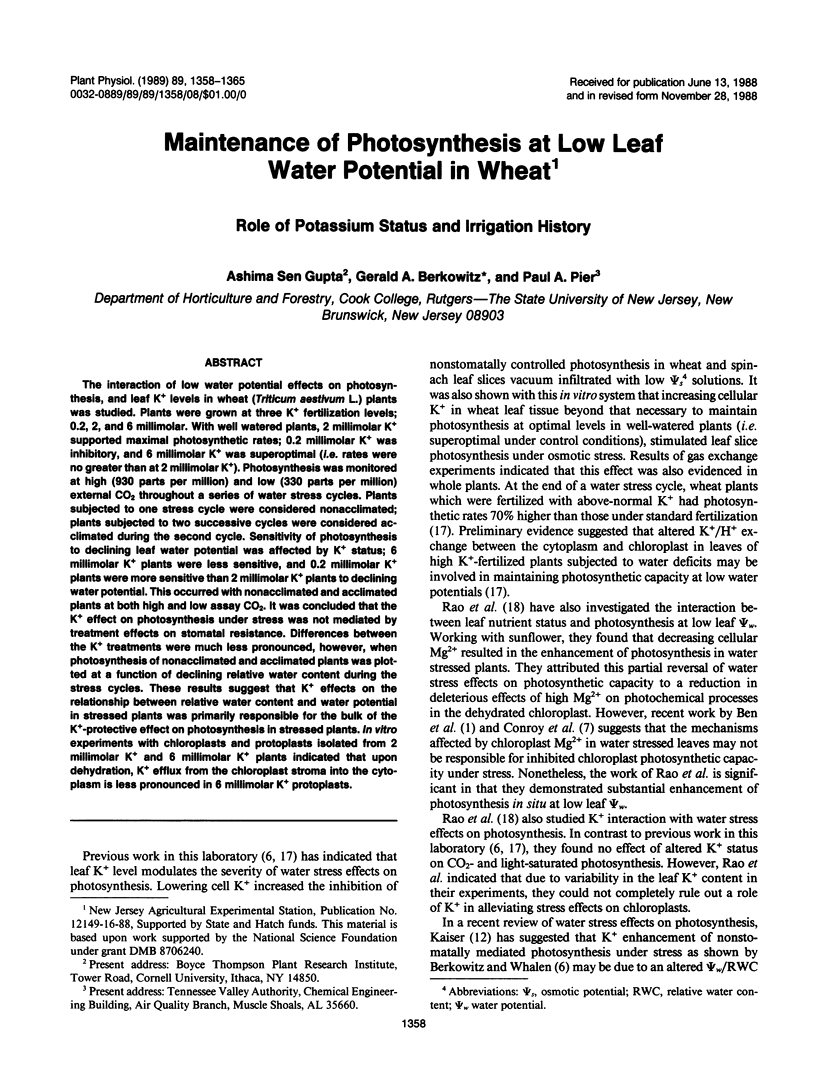
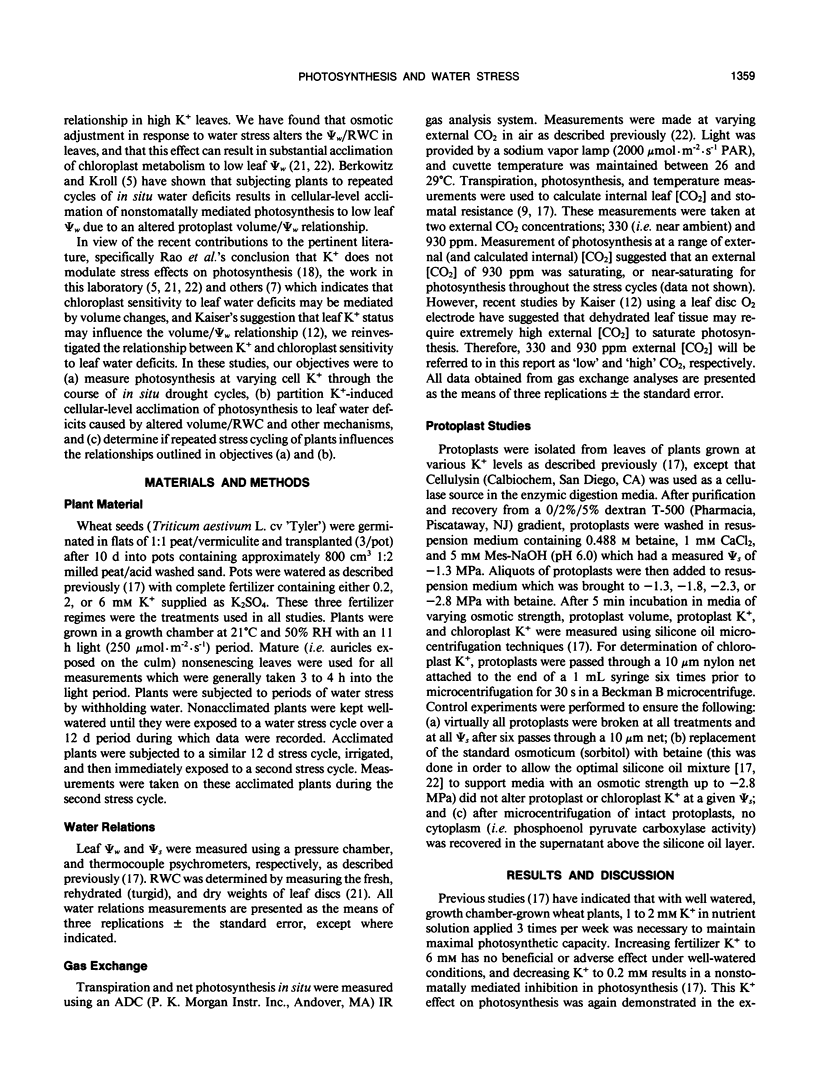
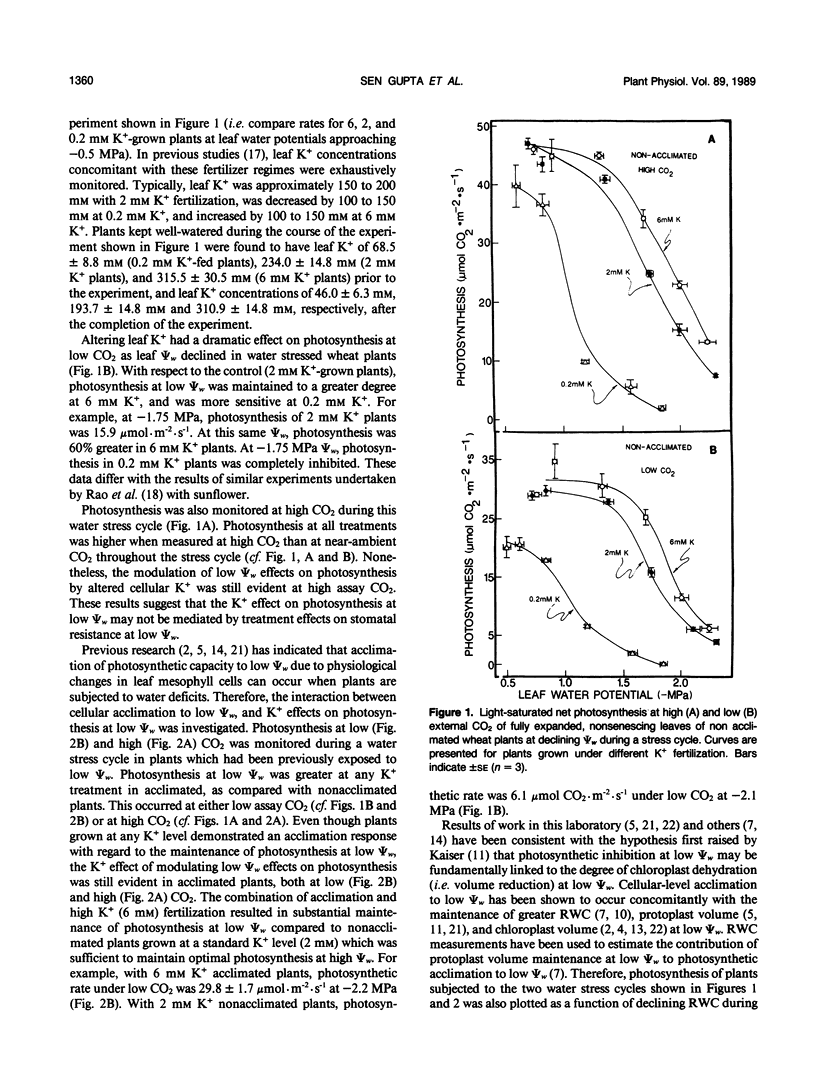

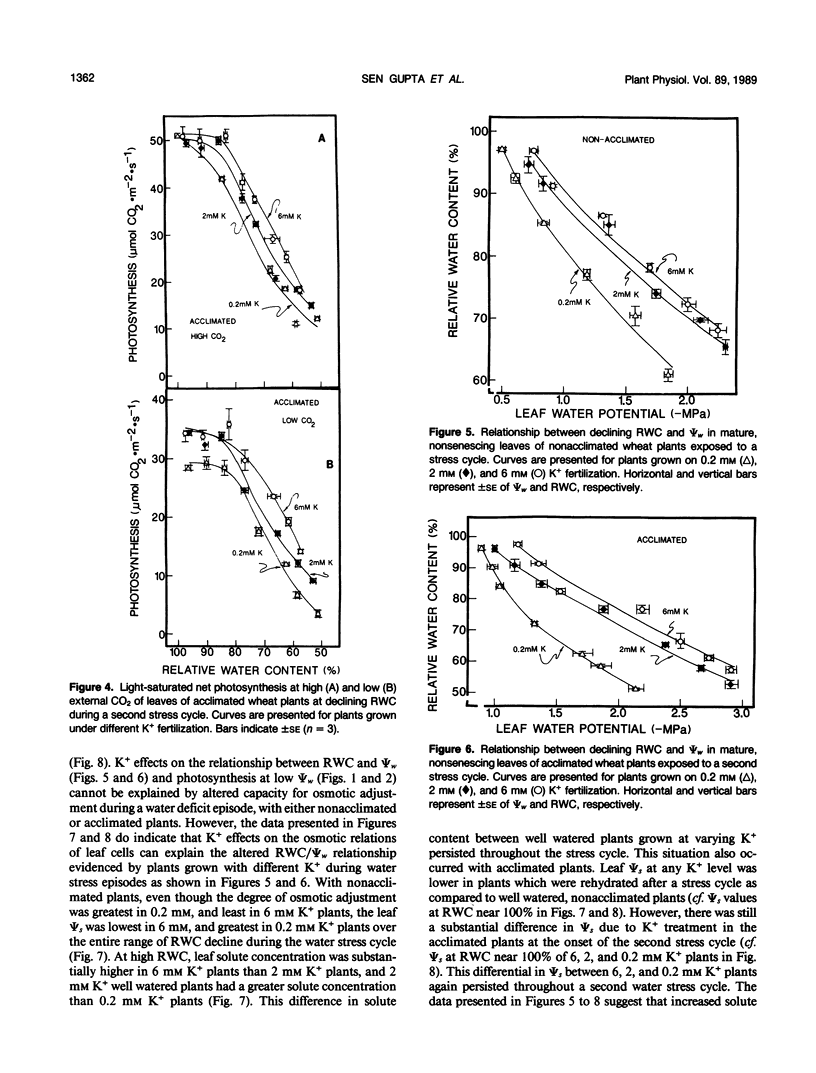
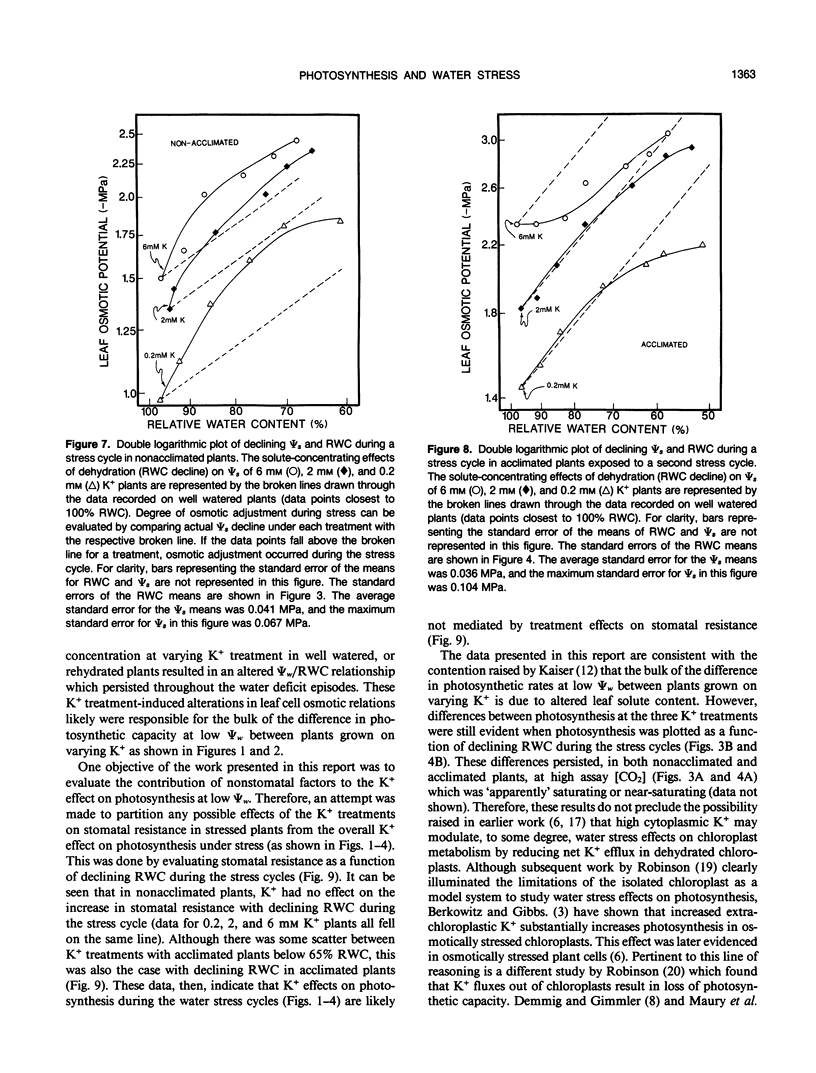
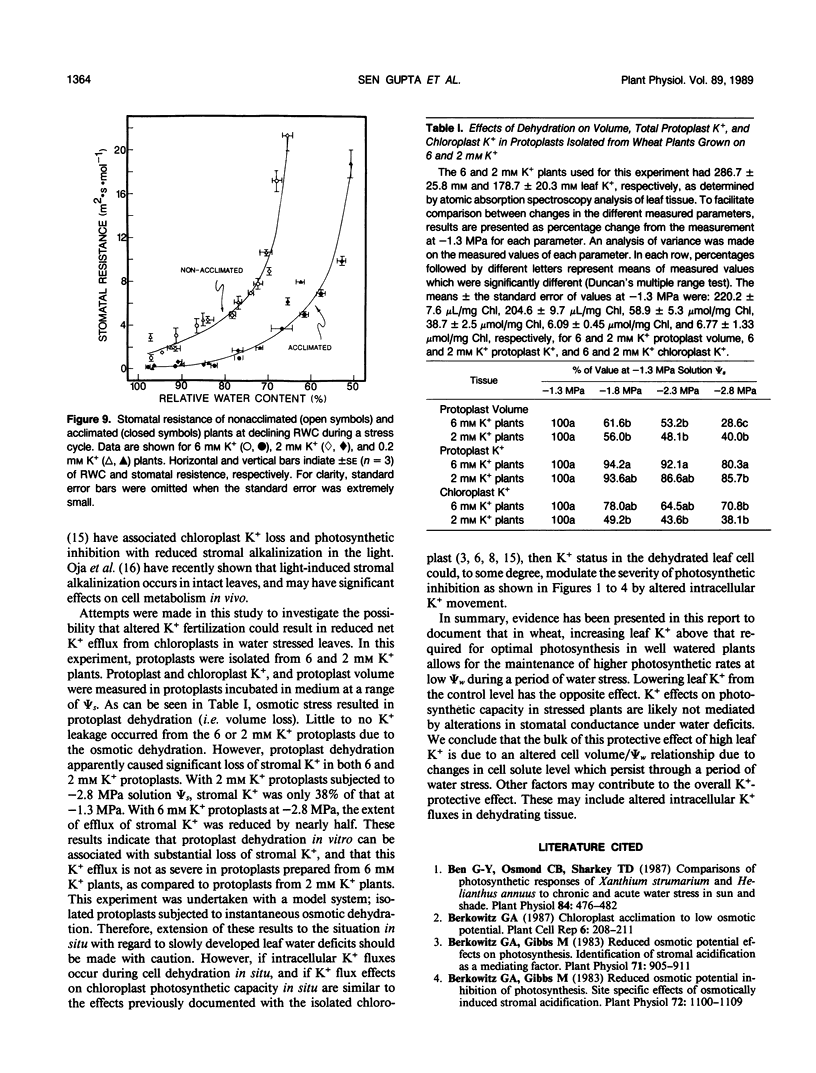

Selected References
These references are in PubMed. This may not be the complete list of references from this article.
- Ben G. Y., Osmond C. B., Sharkey T. D. Comparisons of Photosynthetic Responses of Xanthium strumarium and Helianthus annuus to Chronic and Acute Water Stress in Sun and Shade. Plant Physiol. 1987 Jun;84(2):476–482. doi: 10.1104/pp.84.2.476. [DOI] [PMC free article] [PubMed] [Google Scholar]
- Berkowitz G. A., Gibbs M. Reduced osmotic potential effects on photosynthesis : identification of stromal acidification as a mediating factor. Plant Physiol. 1983 Apr;71(4):905–911. doi: 10.1104/pp.71.4.905. [DOI] [PMC free article] [PubMed] [Google Scholar]
- Berkowitz G. A., Gibbs M. Reduced osmotic potential inhibition of photosynthesis : site-specific effects of osmotically induced stromal acidification. Plant Physiol. 1983 Aug;72(4):1100–1109. doi: 10.1104/pp.72.4.1100. [DOI] [PMC free article] [PubMed] [Google Scholar]
- Berkowitz G. A., Whalen C. Leaf k interaction with water stress inhibition of nonstomatal-controlled photosynthesis. Plant Physiol. 1985 Sep;79(1):189–193. doi: 10.1104/pp.79.1.189. [DOI] [PMC free article] [PubMed] [Google Scholar]
- Conroy J. P., Virgona J. M., Smillie R. M., Barlow E. W. Influence of Drought Acclimation and CO(2) Enrichment on Osmotic Adjustment and Chlorophyll a Fluorescence of Sunflower during Drought. Plant Physiol. 1988 Apr;86(4):1108–1115. doi: 10.1104/pp.86.4.1108. [DOI] [PMC free article] [PubMed] [Google Scholar]
- Demmig B., Gimmler H. Properties of the Isolated Intact Chloroplast at Cytoplasmic K Concentrations : I. Light-Induced Cation Uptake into Intact Chloroplasts is Driven by an Electrical Potential Difference. Plant Physiol. 1983 Sep;73(1):169–174. doi: 10.1104/pp.73.1.169. [DOI] [PMC free article] [PubMed] [Google Scholar]
- Gupta A. S., Berkowitz G. A. Chloroplast osmotic adjustment and water stress effects on photosynthesis. Plant Physiol. 1988 Sep;88(1):200–206. doi: 10.1104/pp.88.1.200. [DOI] [PMC free article] [PubMed] [Google Scholar]
- Gupta A. S., Berkowitz G. A. Osmotic adjustment, symplast volume, and nonstomatally mediated water stress inhibition of photosynthesis in wheat. Plant Physiol. 1987 Dec;85(4):1040–1047. doi: 10.1104/pp.85.4.1040. [DOI] [PMC free article] [PubMed] [Google Scholar]
- Matthews M. A., Boyer J. S. Acclimation of photosynthesis to low leaf water potentials. Plant Physiol. 1984 Jan;74(1):161–166. doi: 10.1104/pp.74.1.161. [DOI] [PMC free article] [PubMed] [Google Scholar]
- Maury W. J., Huber S. C., Moreland D. E. Effects of Magnesium on Intact Chloroplasts : II. CATION SPECIFICITY AND INVOLVEMENT OF THE ENVELOPE ATPase IN (SODIUM) POTASSIUM/PROTON EXCHANGE ACROSS THE ENVELOPE. Plant Physiol. 1981 Dec;68(6):1257–1263. doi: 10.1104/pp.68.6.1257. [DOI] [PMC free article] [PubMed] [Google Scholar]
- Pier P. A., Berkowitz G. A. Modulation of water stress effects on photosynthesis by altered leaf k. Plant Physiol. 1987 Nov;85(3):655–661. doi: 10.1104/pp.85.3.655. [DOI] [PMC free article] [PubMed] [Google Scholar]
- Rao I. M., Sharp R. E., Boyer J. S. Leaf magnesium alters photosynthetic response to low water potentials in sunflower. Plant Physiol. 1987 Aug;84(4):1214–1219. doi: 10.1104/pp.84.4.1214. [DOI] [PMC free article] [PubMed] [Google Scholar]
- Robinson S. P. Osmotic adjustment by intact isolated chloroplasts in response to osmotic stress and its effect on photosynthesis and chloroplast volume. Plant Physiol. 1985 Dec;79(4):996–1002. doi: 10.1104/pp.79.4.996. [DOI] [PMC free article] [PubMed] [Google Scholar]


